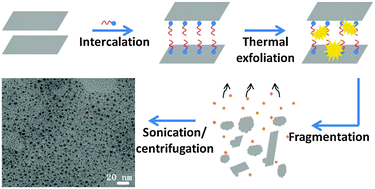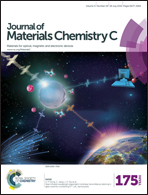Preparation of MoO3 QDs through combining intercalation and thermal exfoliation†
Abstract
Lots of top-down approaches by weakening the van der Waals interaction between adjacent layers and breaking up the covalent chemical bonds in each layer have been reported to prepare QDs of layered materials due to the stacked structures. However, much attention has been focused on graphene and layered transition-metal dichalcogenides (TMDs), seldomly on layered transition-metal oxides (TMOs). Herein, a modified top-down method combining intercalation and thermal exfoliation is reported to prepare high-yield QDs of layered MoO3. Alkylamine was first intercalated into MoO3 layers to weaken the van der Waals forces. Then, the covalent bonds in each MoO3 layer were broken down under a sudden increase in gas pressure generated by the decomposition of alkylamines after rapid heating. These fractured particles were further incised to QDs by sonication. The as-prepared MoO3 QD dispersion showed a plasmon resonance after simulated solar light illumination. Surprisingly, their plasmon peak red shifted with an extended illumination time, which was different from the reported MoO3 nanosheets. This reported method is expected to extend to other QDs of layered materials providing that their bulk materials can also be intercalated.


 Please wait while we load your content...
Please wait while we load your content...